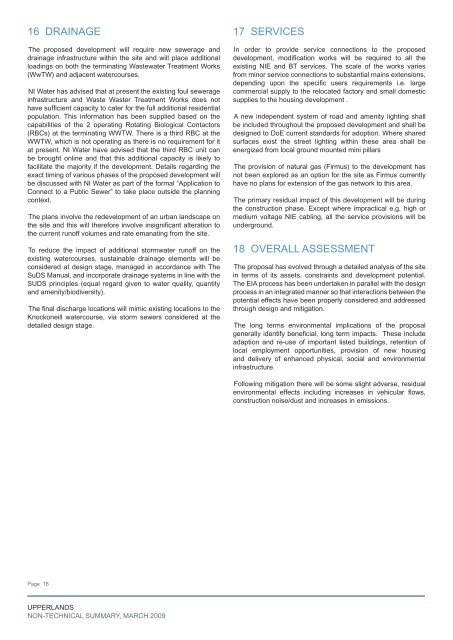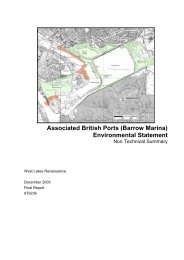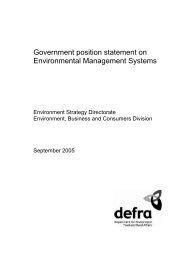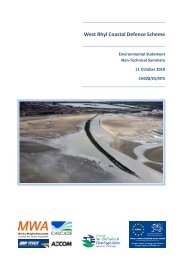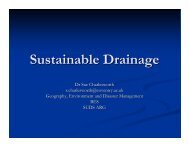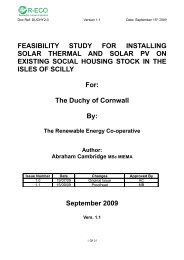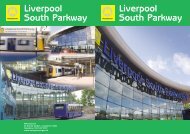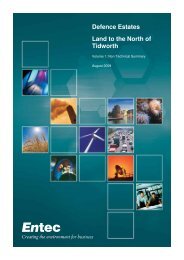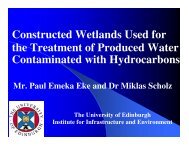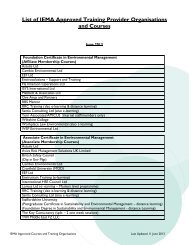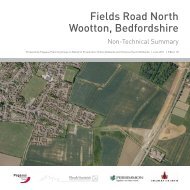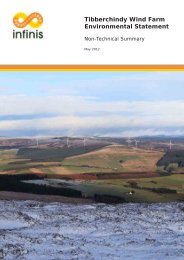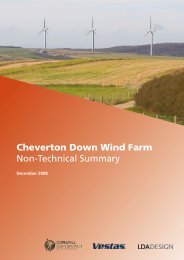upperlands - Institute of Environmental Management and Assessment
upperlands - Institute of Environmental Management and Assessment
upperlands - Institute of Environmental Management and Assessment
Create successful ePaper yourself
Turn your PDF publications into a flip-book with our unique Google optimized e-Paper software.
16 DrainageThe proposed development will require new sewerage <strong>and</strong>drainage infrastructure within the site <strong>and</strong> will place additionalloadings on both the terminating Wastewater Treatment Works(WwTW) <strong>and</strong> adjacent watercourses.NI Water has advised that at present the existing foul sewerageinfrastructure <strong>and</strong> Waste Waster Treatment Works does nothave sufficient capacity to cater for the full additional residentialpopulation. This information has been supplied based on thecapabilities <strong>of</strong> the 2 operating Rotating Biological Contactors(RBCs) at the terminating WWTW. There is a third RBC at theWWTW, which is not operating as there is no requirement for itat present. NI Water have advised that the third RBC unit canbe brought online <strong>and</strong> that this additional capacity is likely t<strong>of</strong>acilitate the majority if the development. Details regarding theexact timing <strong>of</strong> various phases <strong>of</strong> the proposed development willbe discussed with NI Water as part <strong>of</strong> the formal “Application toConnect to a Public Sewer” to take place outside the planningcontext.The plans involve the redevelopment <strong>of</strong> an urban l<strong>and</strong>scape onthe site <strong>and</strong> this will therefore involve insignificant alteration tothe current run<strong>of</strong>f volumes <strong>and</strong> rate emanating from the site.To reduce the impact <strong>of</strong> additional stormwater run<strong>of</strong>f on theexisting watercourses, sustainable drainage elements will beconsidered at design stage, managed in accordance with TheSuDS Manual, <strong>and</strong> incorporate drainage systems in line with theSUDS principles (equal regard given to water quality, quantity<strong>and</strong> amenity/biodiversity).The final discharge locations will mimic existing locations to theKnockoneill watercourse, via storm sewers considered at thedetailed design stage.17 ServicesIn order to provide service connections to the proposeddevelopment, modification works will be required to all theexisting NIE <strong>and</strong> BT services. The scale <strong>of</strong> the works variesfrom minor service connections to substantial mains extensions,depending upon the specific users requirements i.e. largecommercial supply to the relocated factory <strong>and</strong> small domesticsupplies to the housing development .A new independent system <strong>of</strong> road <strong>and</strong> amenity lighting shallbe included throughout the proposed development <strong>and</strong> shall bedesigned to DoE current st<strong>and</strong>ards for adoption. Where sharedsurfaces exist the street lighting within these area shall beenergized from local ground mounted mini pillarsThe provision <strong>of</strong> natural gas (Firmus) to the development hasnot been explored as an option for the site as Firmus currentlyhave no plans for extension <strong>of</strong> the gas network to this area.The primary residual impact <strong>of</strong> this development will be duringthe construction phase. Except where impractical e.g. high ormedium voltage NIE cabling, all the service provisions will beunderground.18 Overall <strong>Assessment</strong>The proposal has evolved through a detailed analysis <strong>of</strong> the sitein terms <strong>of</strong> its assets, constraints <strong>and</strong> development potential.The EIA process has been undertaken in parallel with the designprocess in an integrated manner so that interactions between thepotential effects have been properly considered <strong>and</strong> addressedthrough design <strong>and</strong> mitigation.The long terms environmental implications <strong>of</strong> the proposalgenerally identify beneficial, long term impacts. These includeadaption <strong>and</strong> re-use <strong>of</strong> important listed buildings, retention <strong>of</strong>local employment opportunities, provision <strong>of</strong> new housing<strong>and</strong> delivery <strong>of</strong> enhanced physical, social <strong>and</strong> environmentalinfrastructure.Following mitigation there will be some slight adverse, residualenvironmental effects including increases in vehicular flows,construction noise/dust <strong>and</strong> increases in emissions.Page 18UPPERLANDSNON-TECHNICAL SUMMARY, MARCH 2009


